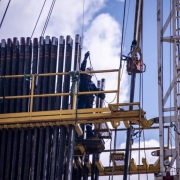การสำรวจบทบาทสำคัญของท่อเหล็กในการสำรวจน้ำมันและก๊าซ
การแนะนำ
ท่อเหล็กมีความสำคัญอย่างยิ่งในอุตสาหกรรมน้ำมันและก๊าซ โดยให้ความทนทานและความน่าเชื่อถือที่ไม่มีใครเทียบได้ภายใต้สภาวะที่รุนแรง ท่อเหล็กมีความจำเป็นสำหรับการสำรวจและการขนส่ง เนื่องจากสามารถทนต่อแรงดันสูง สภาพแวดล้อมที่กัดกร่อน และอุณหภูมิที่รุนแรงได้ หน้าเว็บนี้จะอธิบายหน้าที่สำคัญของท่อเหล็กในการสำรวจน้ำมันและก๊าซ พร้อมทั้งอธิบายรายละเอียดถึงความสำคัญของท่อเหล็กในด้านการขุดเจาะ โครงสร้างพื้นฐาน และความปลอดภัย ค้นพบว่าการเลือกใช้ท่อเหล็กที่เหมาะสมจะช่วยเพิ่มประสิทธิภาพในการดำเนินงานและลดต้นทุนในอุตสาหกรรมที่มีความต้องการสูงนี้ได้อย่างไร
I. ความรู้พื้นฐานเกี่ยวกับท่อเหล็กสำหรับอุตสาหกรรมน้ำมันและก๊าซ
1. คำอธิบายคำศัพท์
เอพีไอ: อักษรย่อของ สถาบันปิโตรเลียมอเมริกัน.
ต.ค.: อักษรย่อของ สินค้าท่อประเทศน้ำมันได้แก่ ท่อปลอกน้ำมัน, ท่อน้ำมัน, ท่อเจาะ, ปลอกเจาะ, ดอกสว่าน, ก้านดูด, ข้อต่อ Pup เป็นต้น
ท่อน้ำมัน: ท่อใช้ในบ่อน้ำมันเพื่อการสกัด การสกัดก๊าซ การฉีดน้ำ และการแตกกรด
ปลอก: ท่อที่ลดลงจากพื้นผิวดินลงไปในหลุมเจาะที่เจาะไว้เพื่อใช้เป็นท่อหุ้มเพื่อป้องกันผนังพังทลาย
ท่อเจาะ: ท่อที่ใช้สำหรับเจาะหลุมเจาะ
เส้นท่อ: ท่อที่ใช้ขนส่งน้ำมันหรือก๊าซ
ข้อต่อ: กระบอกสูบใช้เชื่อมต่อท่อเกลียวสองท่อกับเกลียวภายใน
วัสดุข้อต่อ: ท่อที่ใช้ในการผลิตข้อต่อ
เธรด API: เกลียวท่อที่กำหนดตามมาตรฐาน API 5B ได้แก่ เกลียวท่อกลมน้ำมัน เกลียวท่อกลมสั้น เกลียวท่อกลมยาว เกลียวท่อสี่เหลี่ยมคางหมูบางส่วน เกลียวท่อส่งน้ำมัน ฯลฯ
การเชื่อมต่อแบบพรีเมียม: เธรดที่ไม่ใช่ API ที่มีคุณสมบัติการปิดผนึก คุณสมบัติการเชื่อมต่อ และคุณสมบัติอื่นๆ ที่ไม่ซ้ำกัน
ความล้มเหลว: การเสียรูป การแตกหัก ความเสียหายของพื้นผิว และการสูญเสียการทำงานเดิมภายใต้เงื่อนไขการบริการเฉพาะ
รูปแบบหลักของความล้มเหลว: การบดอัด การลื่น การแตก การรั่วซึม การกัดกร่อน การยึดติด การสึกหรอ ฯลฯ
2. มาตรฐานที่เกี่ยวข้องกับปิโตรเลียม
API Spec 5B ฉบับที่ 17 – ข้อกำหนดสำหรับการทำเกลียว การวัด และการตรวจสอบเกลียวของท่อ ท่อ และเกลียวท่อ
ข้อมูลจำเพาะ API 5L ฉบับที่ 46 – ข้อกำหนดสำหรับท่อเส้น
API Spec 5CT ฉบับที่ 11 – ข้อกำหนดสำหรับปลอกและท่อ
ข้อมูลจำเพาะ API 5DP ฉบับที่ 7 – ข้อกำหนดสำหรับท่อเจาะ
ข้อมูลจำเพาะ API 7-1 ฉบับที่ 2 – ข้อกำหนดสำหรับองค์ประกอบต้นกำเนิดสว่านโรตารี
ข้อมูลจำเพาะ API 7-2 ฉบับที่ 2 – ข้อกำหนดสำหรับการทำเกลียวและการวัดการเชื่อมต่อเกลียวแบบมีไหล่แบบหมุน
ข้อมูลจำเพาะ API 11B ฉบับที่ 24 – ข้อกำหนดสำหรับแท่งดูด, แท่งและไลเนอร์ขัดเงา, ข้อต่อ, บาร์จม, ที่หนีบแท่งขัดเงา, กล่องบรรจุและประเดิมปั๊ม
ISO 3183:2019 – อุตสาหกรรมปิโตรเลียมและก๊าซธรรมชาติ — ท่อเหล็กสำหรับระบบขนส่งทางท่อ
ใบรับรองมาตรฐาน ISO 11960:2020 – อุตสาหกรรมปิโตรเลียมและก๊าซธรรมชาติ – ท่อเหล็กสำหรับใช้เป็นท่อหรือท่อสำหรับบ่อ
NACE MR0175 / ISO 15156:2020 – อุตสาหกรรมปิโตรเลียมและก๊าซธรรมชาติ — วัสดุสำหรับใช้ในสภาพแวดล้อมที่มี H2S ในการผลิตน้ำมันและก๊าซ
ครั้งที่สอง ท่อน้ำมัน
1. การจำแนกประเภทของท่อน้ำมัน
ท่อส่งน้ำมันแบ่งออกเป็นท่อส่งน้ำมันแบบไม่ยกตัว (NU), ท่อส่งน้ำมันแบบยกตัวภายนอก (EU) และท่อส่งน้ำมันแบบต่อท่อ (IJ) ท่อส่งน้ำมันแบบ NU หมายถึง ปลายท่อมีความหนาปานกลาง บิดเกลียวโดยตรง และต่อข้อต่อ ท่อยกตัว หมายถึง ปลายท่อทั้งสองข้างยกตัวภายนอก จากนั้นจึงขันเกลียวและต่อเข้าด้วยกัน ท่อแบบต่อท่อรวม หมายถึง ปลายด้านหนึ่งของท่อยกตัวด้วยเกลียวภายนอก และอีกด้านยกตัวด้วยเกลียวภายในที่ต่อโดยตรงโดยไม่ต้องใช้ข้อต่อ
2. ฟังก์ชั่นของท่อน้ำมัน
1 การสกัดน้ำมันและก๊าซ: หลังจากเจาะและประสานบ่อน้ำมันและก๊าซแล้ว ท่อจะถูกวางไว้ในท่อน้ำมันเพื่อแยกน้ำมันและก๊าซลงสู่พื้นดิน
2. การฉีดน้ำ: เมื่อแรงดันในหลุมเจาะไม่เพียงพอ ให้ฉีดน้ำเข้าไปในบ่อผ่านท่อ
③ การฉีดไอน้ำ: ในการกู้คืนน้ำมันหนาด้วยความร้อน ไอจะถูกป้อนเข้าไปในหลุมที่มีท่อน้ำมันที่หุ้มฉนวน
④ การเกิดกรดและการแตกหัก: ในขั้นตอนปลายของการขุดเจาะบ่อน้ำมันหรือเพื่อปรับปรุงการผลิตน้ำมันและก๊าซ จำเป็นต้องป้อนตัวกลางการเกิดกรดและการแตกหักหรือวัสดุบ่มลงในชั้นน้ำมันและก๊าซ จากนั้นตัวกลางและวัสดุบ่มจะถูกขนส่งผ่านท่อน้ำมัน
3. ท่อเหล็กเกรดเหล็ก
เกรดเหล็กของท่อน้ำมันคือ H40, J55, N80, L80, C90, T95, P110
N80 แบ่งออกเป็น N80-1 และ N80Q โดยทั้งสองมีสมบัติการดึงเหมือนกัน ความแตกต่างสองประการคือสถานะการส่งมอบและความแตกต่างของประสิทธิภาพในการรับแรงกระแทก โดยการส่งมอบ N80-1 โดยสถานะปกติหรือเมื่ออุณหภูมิการรีดขั้นสุดท้ายมากกว่าอุณหภูมิวิกฤต Ar3 และการลดแรงดึงหลังจากการระบายความร้อนด้วยอากาศ และสามารถใช้เพื่อค้นหาการรีดร้อนแทนการปกติ ไม่จำเป็นต้องทดสอบแรงกระแทกและไม่ทำลายล้าง N80Q ต้องผ่านการอบชุบ (ชุบแข็งและอบชุบ) การอบด้วยความร้อน ฟังก์ชันการกระแทกควรเป็นไปตามบทบัญญัติของ API 5CT และควรทดสอบแบบไม่ทำลายล้าง
L80 แบ่งออกเป็น L80-1, L80-9Cr และ L80-13Cr คุณสมบัติทางกลและสถานะการจัดส่งเหมือนกัน ความแตกต่างในการใช้งาน ความยากในการผลิต และราคา: L80-1 เป็นท่อประเภททั่วไป ส่วน L80-9Cr และ L80-13Cr เป็นท่อที่มีความต้านทานการกัดกร่อนสูง มีความยากในการผลิต และมีราคาแพง มักใช้ในบ่อน้ำที่มีการกัดกร่อนสูง
C90 และ T95 แบ่งออกเป็น 1 และ 2 ประเภท คือ C90-1, C90-2 และ T95-1, T95-2.
4. ท่อน้ำมันเกรดเหล็กที่ใช้กันทั่วไป ชื่อเหล็ก และสถานะการจัดส่ง
J55 (37Mn5) ท่อน้ำมัน NU: รีดร้อนแทนการทำให้เป็นมาตรฐาน
J55 (37Mn5) ท่อน้ำมันของ EU: ความยาวเต็มทำให้เป็นมาตรฐานหลังจากอารมณ์เสีย
ท่อน้ำมัน N80-1 (36Mn2V) NU: รีดร้อนแทนการทำให้เป็นมาตรฐาน
N80-1 (36Mn2V) ท่อน้ำมัน EU: ความยาวเต็มทำให้เป็นมาตรฐานหลังจากการปั่นป่วน
ท่อน้ำมัน N80-Q (30Mn5): 30Mn5, การแบ่งเบาบรรเทาแบบเต็มความยาว
L80-1 (30Mn5) ท่อน้ำมัน: 30Mn5, การแบ่งเบาบรรเทาแบบเต็มความยาว
P110 (25CrMnMo) ท่อน้ำมัน: 25CrMnMo, การแบ่งเบาบรรเทาเต็มความยาว
J55 (37Mn5) ข้อต่อ: เหล็กแผ่นรีดร้อนออนไลน์ทำให้เป็นมาตรฐาน
ข้อต่อ N80 (28MnTiB): การแบ่งเบาบรรเทาแบบเต็มความยาว
ข้อต่อ L80-1 (28MnTiB): นิรภัยเต็มความยาว
ข้อต่อ P110 (25CrMnMo): การแบ่งเบาบรรเทาแบบเต็มความยาว
สาม. ท่อปลอก
1. การจำแนกประเภทและบทบาทของปลอก
ตัวเรือนเป็นท่อเหล็กที่รองรับผนังบ่อน้ำมันและก๊าซ แต่ละหลุมใช้เคสหลายชั้นตามความลึกของการเจาะและสภาพทางธรณีวิทยาที่แตกต่างกัน ปูนซิเมนต์ใช้ในการประสานท่อหลังจากหย่อนลงไปในบ่อ และไม่เหมือนกับท่อน้ำมันและท่อเจาะตรงที่ไม่สามารถนำกลับมาใช้ใหม่ได้และเป็นของวัสดุสิ้นเปลืองแบบใช้แล้วทิ้ง ดังนั้นการใช้ท่อมีสัดส่วนมากกว่าร้อยละ 70 ของท่อบ่อน้ำมันทั้งหมด ปลอกสามารถแบ่งออกเป็นปลอกตัวนำ ปลอกกลาง ปลอกการผลิต และปลอกซับตามการใช้งาน และโครงสร้างในบ่อน้ำมันแสดงในรูปที่ 1

1. ปลอกตัวนำ: โดยทั่วไปแล้ว เมื่อใช้เกรด API K55, J55 หรือ H40 เคสตัวนำจะทำให้หลุมผลิตมีความเสถียร และแยกชั้นหินอุ้มน้ำตื้นๆ ที่มีเส้นผ่านศูนย์กลางโดยทั่วไปประมาณ 20 นิ้วหรือ 16 นิ้ว
②ปลอกระดับกลาง: เคสระดับกลางซึ่งมักทำจากเกรด API K55, N80, L80 หรือ P110 ใช้เพื่อแยกการก่อตัวที่ไม่เสถียรและโซนแรงดันที่แตกต่างกัน โดยมีเส้นผ่านศูนย์กลางทั่วไป 13 3/8 นิ้ว, 11 3/4 นิ้ว หรือ 9 5/8 นิ้ว .
3. ปลอกการผลิต: โครงสร้างผลิตจากเหล็กเกรดสูง เช่น เกรด API J55, N80, L80, P110 หรือ Q125 เคสการผลิตได้รับการออกแบบมาให้ทนต่อแรงกดดันในการผลิต โดยทั่วไปจะมีเส้นผ่านศูนย์กลาง 9 5/8 นิ้ว 7 นิ้ว หรือ 5 1/2 นิ้ว
④ปลอกไลเนอร์: แผ่นบุจะขยายรูเจาะเข้าไปในแหล่งเก็บน้ำมันโดยใช้วัสดุ เช่น เกรด API L80, N80 หรือ P110 โดยมีเส้นผ่านศูนย์กลางทั่วไปที่ 7 นิ้ว 5 นิ้ว หรือ 4 1/2 นิ้ว
⑤ท่อ: ท่อขนส่งไฮโดรคาร์บอนสู่พื้นผิวโดยใช้เกรด API J55, L80 หรือ P110 และมีจำหน่ายในเส้นผ่านศูนย์กลาง 4 1/2 นิ้ว, 3 1/2 นิ้ว หรือ 2 7/8 นิ้ว
IV. ท่อเจาะ
1. การจำแนกประเภทและหน้าที่ของท่อสำหรับเครื่องมือเจาะ
ท่อเจาะสี่เหลี่ยม ท่อเจาะ ท่อเจาะที่มีน้ำหนัก และปลอกเจาะในเครื่องมือเจาะประกอบกันเป็นท่อเจาะ ท่อเจาะเป็นเครื่องมือเจาะแกนที่ขับเคลื่อนหัวเจาะจากพื้นดินไปยังก้นหลุม และยังเป็นช่องทางจากพื้นดินไปยังก้นหลุมอีกด้วย ท่อเจาะมีบทบาทนำสามประการ:
1 เพื่อส่งแรงบิดเพื่อขับเคลื่อนสว่านเพื่อเจาะ
② การอาศัยน้ำหนักของมันไปที่ดอกสว่านเพื่อทำลายแรงดันของหินที่ก้นบ่อน้ำ
3 เพื่อขนส่งน้ำยาล้าง นั่นคือ การเจาะโคลนผ่านพื้นดินผ่านปั๊มโคลนแรงดันสูง เจาะคอลัมน์เข้าไปในรูเจาะที่ไหลลงด้านล่างของบ่อเพื่อล้างเศษหินและทำให้สว่านเย็นลง และขนเศษหิน ผ่านพื้นผิวด้านนอกของคอลัมน์และผนังของบ่อน้ำระหว่างวงแหวนเพื่อกลับสู่พื้นเพื่อให้บรรลุวัตถุประสงค์ของการขุดเจาะบ่อน้ำ
ท่อเจาะใช้ในกระบวนการเจาะเพื่อทนต่อแรงสลับซับซ้อนต่างๆ เช่น แรงดึง แรงอัด แรงบิด แรงดัด และแรงเครียดอื่นๆ นอกจากนี้ พื้นผิวด้านในยังต้องสัมผัสกับโคลนที่มีแรงดันสูงและการกัดกร่อนอีกด้วย
(1) ท่อเจาะสี่เหลี่ยม: ท่อเจาะสี่เหลี่ยมมี 2 ประเภท ได้แก่ สี่เหลี่ยมและหกเหลี่ยม ในท่อเจาะน้ำมันปิโตรเลียมของจีน คอลัมน์เจาะแต่ละชุดมักใช้ท่อเจาะประเภทสี่เหลี่ยม โดยมีข้อกำหนดคือ 63.5 มม. (2-1/2 นิ้ว), 88.9 มม. (3-1/2 นิ้ว), 107.95 มม. (4-1/4 นิ้ว), 133.35 มม. (5-1/4 นิ้ว), 152.4 มม. (6 นิ้ว) เป็นต้น ความยาวที่ใช้โดยทั่วไปคือ 1,214.5 ม.
(2) ท่อเจาะ: ท่อเจาะเป็นเครื่องมือหลักในการเจาะบ่อน้ำ โดยเชื่อมต่อกับปลายด้านล่างของท่อเจาะทรงสี่เหลี่ยม และเมื่อบ่อน้ำเจาะลึกมากขึ้น ท่อเจาะก็จะขยายความยาวของเสาเจาะทีละอัน ข้อมูลจำเพาะของท่อเจาะ ได้แก่ 60.3 มม. (2-3/8 นิ้ว) 73.03 มม. (2-7/8 นิ้ว) 88.9 มม. (3-1/2 นิ้ว) 114.3 มม. (4-1/2 นิ้ว) 127 มม. (5 นิ้ว) 139.7 มม. (5-1/2 นิ้ว) เป็นต้น
(3) ท่อเจาะสำหรับงานหนัก: ท่อเจาะถ่วงน้ำหนักเป็นเครื่องมือเปลี่ยนผ่านที่เชื่อมต่อท่อเจาะและปลอกเจาะ ซึ่งสามารถปรับปรุงสภาพแรงของท่อเจาะ และเพิ่มแรงดันบนดอกสว่าน ข้อมูลจำเพาะหลักของท่อเจาะถ่วงน้ำหนักคือ 88.9 มม. (3-1/2 นิ้ว) และ 127 มม. (5 นิ้ว)
(4) ปลอกเจาะ: ปลอกสว่านเชื่อมต่อกับส่วนล่างของท่อสว่าน ซึ่งเป็นท่อที่มีผนังหนาพิเศษที่มีความแข็งแกร่งสูง ท่อนี้จะสร้างแรงกดบนดอกสว่านเพื่อทำลายหิน และทำหน้าที่เป็นแนวทางในการเจาะหลุมตรง ข้อกำหนดทั่วไปของปลอกสว่านคือ 158.75 มม. (6-1/4 นิ้ว), 177.85 มม. (7 นิ้ว), 203.2 มม. (8 นิ้ว), 228.6 มม. (9 นิ้ว) เป็นต้น
ท่อวีไลน์
1. การจำแนกประเภทของท่อเส้น
ท่อส่งน้ำมันและก๊าซใช้ในอุตสาหกรรมน้ำมันและก๊าซเพื่อส่งน้ำมัน น้ำมันกลั่น ก๊าซธรรมชาติ และท่อส่งน้ำโดยใช้ตัวย่อว่าท่อเหล็ก ท่อส่งน้ำมันและก๊าซแบ่งออกเป็นท่อหลัก ท่อสาขา และท่อเครือข่ายท่อส่งในเมือง ท่อส่งหลักสามประเภทมีข้อกำหนดทั่วไปคือ ∅406 ~ 1219 มม. ความหนาของผนัง 10 ~ 25 มม. เกรดเหล็ก X42 ~ X80 ท่อสาขาและท่อเครือข่ายท่อส่งในเมืองมักมีข้อกำหนดสำหรับ ∅114 ~ 700 มม. ความหนาของผนัง 6 ~ 20 มม. เกรดเหล็กสำหรับ X42 ~ X80 เกรดเหล็กคือ X42~X80 ท่อส่งน้ำมันมีแบบเชื่อมและแบบไร้รอยต่อ ท่อส่งน้ำมันแบบเชื่อมใช้มากกว่าท่อส่งน้ำมันแบบไร้รอยต่อ
2. มาตรฐานของไลน์ท่อ
API Spec 5L – ข้อกำหนดสำหรับ Line Pipe
ISO 3183 - อุตสาหกรรมปิโตรเลียมและก๊าซธรรมชาติ - ท่อเหล็กสำหรับระบบขนส่งทางท่อ
3. PSL1 และ PSL2
PSL คือคำย่อของ ระดับคุณลักษณะของผลิตภัณฑ์ระดับข้อมูลจำเพาะของผลิตภัณฑ์ท่อแบ่งออกเป็น PSL 1 และ PSL 2 และระดับคุณภาพแบ่งออกเป็น PSL 1 และ PSL 2 โดย PSL 2 สูงกว่า PSL 1 ระดับข้อมูลจำเพาะทั้งสองระดับไม่เพียงแต่มีข้อกำหนดการทดสอบที่แตกต่างกัน แต่ข้อกำหนดองค์ประกอบทางเคมีและคุณสมบัติทางกลก็แตกต่างกันด้วย ดังนั้น ตามลำดับ API 5L เงื่อนไขของสัญญา นอกเหนือจากการระบุข้อมูลจำเพาะ เกรดเหล็ก และตัวบ่งชี้ทั่วไปอื่นๆ แล้ว ยังต้องระบุระดับข้อมูลจำเพาะของผลิตภัณฑ์ด้วย นั่นคือ PSL 1 หรือ PSL 2 โดย PSL 2 ในองค์ประกอบทางเคมี คุณสมบัติแรงดึง กำลังแรงกระแทก การทดสอบแบบไม่ทำลาย และตัวบ่งชี้อื่นๆ จะเข้มงวดกว่า PSL 1
4. เกรดเหล็กท่อเส้น องค์ประกอบทางเคมี และคุณสมบัติทางกล
เกรดเหล็กท่ออ่อนตั้งแต่ต่ำไปจนถึงสูงแบ่งออกเป็น A25, A, B, X42, X46, X52, X60, X65, X70 และ X80 สำหรับองค์ประกอบทางเคมีและคุณสมบัติเชิงกลโดยละเอียด โปรดดูที่หนังสือ API 5L Specification ฉบับที่ 46
5. ข้อกำหนดการทดสอบอุทกสถิตของท่อเส้นและข้อกำหนดการตรวจสอบแบบไม่ทำลาย
ท่อสายควรทำการทดสอบระบบไฮดรอลิกแบบแยกสาขา และมาตรฐานไม่อนุญาตให้สร้างแรงดันไฮดรอลิกแบบไม่ทำลายล้าง ซึ่งถือเป็นความแตกต่างอย่างมากระหว่างมาตรฐาน API และมาตรฐานของเรา PSL 1 ไม่ต้องการการทดสอบแบบไม่ทำลายล้าง ส่วน PSL 2 ควรทำการทดสอบแบบไม่ทำลายล้างแบบแยกสาขา
วี. การเชื่อมต่อระดับพรีเมียม
1. การแนะนำการเชื่อมต่อแบบพรีเมียม
การเชื่อมต่อแบบพรีเมี่ยมเป็นเกลียวท่อที่มีโครงสร้างเฉพาะที่แตกต่างจากเกลียว API แม้ว่าปลอกท่อน้ำมันแบบเกลียว API ที่มีอยู่จะถูกนำมาใช้กันอย่างแพร่หลายในการสำรวจแหล่งน้ำมัน แต่ข้อบกพร่องของปลอกท่อก็แสดงให้เห็นอย่างชัดเจนในสภาพแวดล้อมเฉพาะของแหล่งน้ำมันบางแห่ง: คอลัมน์ท่อเกลียวกลม API แม้ว่าประสิทธิภาพการปิดผนึกจะดีกว่า แต่แรงดึงที่ส่วนเกลียวรับได้นั้นเทียบเท่ากับความแข็งแรงของตัวท่อ 60% ถึง 80% เท่านั้น ดังนั้นจึงไม่สามารถใช้ในการสำรวจหลุมลึกได้ คอลัมน์ท่อเกลียวสี่เหลี่ยมคางหมูแบบมีอคติ API แม้ว่าประสิทธิภาพการดึงจะสูงกว่าการเชื่อมต่อเกลียวกลม API มาก แต่ประสิทธิภาพการปิดผนึกไม่ดีนัก แม้ว่าประสิทธิภาพการดึงของคอลัมน์จะสูงกว่าการเชื่อมต่อเกลียวกลม API มาก แต่ประสิทธิภาพการปิดผนึกไม่ดีนัก จึงไม่สามารถใช้ในการสำรวจหลุมก๊าซแรงดันสูงได้ นอกจากนี้ จารบีเกลียวจะทำหน้าที่ได้เฉพาะในสภาพแวดล้อมที่มีอุณหภูมิต่ำกว่า 95℃ เท่านั้น จึงไม่สามารถนำไปใช้ในการขุดเจาะบ่อน้ำที่มีอุณหภูมิสูงได้
เมื่อเปรียบเทียบกับการเชื่อมต่อเธรดแบบกลม API และเธรดสี่เหลี่ยมคางหมูบางส่วน การเชื่อมต่อแบบพรีเมียมมีความก้าวหน้าอย่างมากในด้านต่อไปนี้:
(1) การปิดผนึกที่ดี ด้วยความยืดหยุ่นและการออกแบบโครงสร้างการปิดผนึกด้วยโลหะ ทำให้การปิดผนึกก๊าซข้อต่อมีความทนทานต่อการเข้าถึงขีดจำกัดของตัวท่อภายในความดันผลผลิต
(2) ความแข็งแรงสูงของการเชื่อมต่อ โดยเชื่อมต่อด้วยการเชื่อมต่อหัวเข็มขัดพิเศษของท่อน้ำมัน ความแข็งแรงของการเชื่อมต่อถึงหรือเกินความแข็งแรงของตัวท่อ เพื่อแก้ปัญหาการลื่นไถลโดยพื้นฐาน
(3) โดยการเลือกวัสดุและการปรับปรุงกระบวนการรักษาพื้นผิว แก้ไขปัญหาของหัวเข็มขัดด้ายติดโดยทั่วไป
(4) ผ่านการเพิ่มประสิทธิภาพของโครงสร้างเพื่อให้การกระจายความเค้นร่วมมีความสมเหตุสมผลและเอื้อต่อความต้านทานต่อการกัดกร่อนของความเค้นมากขึ้น
(5) ผ่านโครงสร้างไหล่ที่มีการออกแบบที่สมเหตุสมผล ทำให้การใช้งานหัวเข็มขัดสามารถเข้าถึงได้มากขึ้น
อุตสาหกรรมน้ำมันและก๊าซมีข้อต่อพรีเมียมที่จดสิทธิบัตรมากกว่า 100 แบบ ซึ่งถือเป็นความก้าวหน้าครั้งสำคัญในเทคโนโลยีท่อ การออกแบบเกลียวแบบพิเศษเหล่านี้ให้ความสามารถในการปิดผนึกที่เหนือกว่า ความแข็งแรงของข้อต่อที่เพิ่มขึ้น และทนทานต่อความเครียดจากสิ่งแวดล้อมได้ดีขึ้น นวัตกรรมเหล่านี้ช่วยแก้ปัญหาต่างๆ เช่น แรงดันสูง สภาพแวดล้อมที่กัดกร่อน และอุณหภูมิที่รุนแรง ทำให้มั่นใจได้ว่ามีความน่าเชื่อถือและประสิทธิภาพที่ยอดเยี่ยมในการดำเนินการที่ปลอดภัยต่อน้ำมันทั่วโลก การวิจัยและพัฒนาอย่างต่อเนื่องในข้อต่อพรีเมียมเน้นย้ำถึงบทบาทสำคัญในการสนับสนุนแนวทางการขุดเจาะที่ปลอดภัยและมีประสิทธิผลมากขึ้น ซึ่งสะท้อนถึงความมุ่งมั่นอย่างต่อเนื่องเพื่อความเป็นเลิศทางเทคโนโลยีในภาคพลังงาน
การเชื่อมต่อVAM®: การเชื่อมต่อ VAM® เป็นที่รู้จักในด้านประสิทธิภาพที่แข็งแกร่งในสภาพแวดล้อมที่ท้าทาย มาพร้อมเทคโนโลยีการปิดผนึกระหว่างโลหะกับโลหะขั้นสูงและความสามารถด้านแรงบิดสูง ช่วยให้มั่นใจได้ถึงการทำงานที่เชื่อถือได้ในบ่อน้ำลึกและแหล่งกักเก็บแรงดันสูง
TenarisHydril Wedge Series: ซีรีส์นี้นำเสนอการเชื่อมต่อที่หลากหลาย เช่น Blue®, Dopeless® และ Wedge 521® ซึ่งขึ้นชื่อในเรื่องการปิดผนึกก๊าซอย่างดีเยี่ยมและความต้านทานต่อแรงอัดและแรงตึง ซึ่งช่วยเพิ่มความปลอดภัยและประสิทธิภาพในการปฏิบัติงาน
ทีเอสเอช® บลู: ออกแบบโดย Tenaris การเชื่อมต่อ TSH® Blue ใช้การออกแบบบ่าคู่ที่เป็นเอกสิทธิ์และโปรไฟล์เกลียวประสิทธิภาพสูง ให้ความทนทานต่อความล้าที่ดีเยี่ยมและง่ายต่อการประกอบในงานเจาะที่สำคัญ
ให้การเชื่อมต่อ Prideco™ XT®: การเชื่อมต่อ XT® ที่ออกแบบโดย NOV ประกอบด้วยซีลโลหะต่อโลหะที่เป็นเอกลักษณ์และรูปแบบเกลียวที่แข็งแรง ช่วยให้มั่นใจถึงความจุแรงบิดที่เหนือกว่าและความต้านทานต่อการสึกกร่อน จึงยืดอายุการใช้งานของการเชื่อมต่อได้
การเชื่อมต่อการล่าสัตว์ Seal-Lock®: การเชื่อมต่อ Seal-Lock® โดย Hunting โดดเด่นด้วยการซีลโลหะต่อโลหะและโปรไฟล์เกลียวที่เป็นเอกลักษณ์ มีชื่อเสียงในด้านความต้านทานแรงดันที่เหนือกว่าและความน่าเชื่อถือในการขุดเจาะทั้งบนบกและนอกชายฝั่ง
บทสรุป
โดยสรุป เครือข่ายท่อเหล็กที่ซับซ้อนซึ่งมีความสำคัญต่ออุตสาหกรรมน้ำมันและก๊าซประกอบด้วยอุปกรณ์เฉพาะทางมากมายที่ออกแบบมาเพื่อทนต่อสภาพแวดล้อมที่เข้มงวดและความต้องการในการดำเนินงานที่ซับซ้อน ตั้งแต่ท่อหุ้มพื้นฐานที่รองรับและปกป้องผนังที่แข็งแรงไปจนถึงท่ออเนกประสงค์ที่ใช้ในกระบวนการสกัดและฉีด ท่อแต่ละประเภทมีจุดประสงค์ที่แตกต่างกันในการสำรวจ ผลิต และขนส่งไฮโดรคาร์บอน มาตรฐานเช่นข้อกำหนดของ API ช่วยให้มั่นใจถึงความสม่ำเสมอและคุณภาพทั่วทั้งท่อเหล่านี้ ในขณะที่นวัตกรรม เช่น การเชื่อมต่อระดับพรีเมียมช่วยเพิ่มประสิทธิภาพในสภาวะที่ท้าทาย เมื่อเทคโนโลยีพัฒนาขึ้น ส่วนประกอบที่สำคัญเหล่านี้จะก้าวหน้าขึ้น ขับเคลื่อนประสิทธิภาพและความน่าเชื่อถือในการดำเนินการด้านพลังงานทั่วโลก การทำความเข้าใจท่อเหล่านี้และข้อกำหนดของท่อเน้นย้ำถึงบทบาทที่ขาดไม่ได้ของท่อเหล่านี้ในโครงสร้างพื้นฐานของภาคส่วนพลังงานสมัยใหม่





